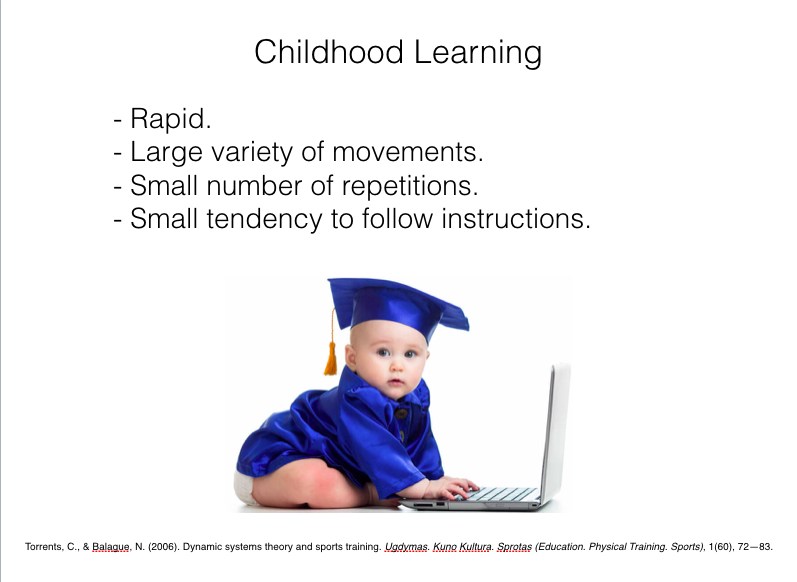.
The picture above is from a presentation on skill development. The paper by Torrents and Balague (2006) found that children learn rapidly, with variety, without many repetitions, and with minimal following of directions.
Compare their descriptions of learning with the tweet. The coach is advocating a lack of variety, a large number of repetitions, and a desire for players to follow directions. Also, it is implied that this learning is not rapid, as one expects that a coach/trainer would not repeat the same thing over and over after it has been mastered.
Who is correct? Do children need to learn to do large number of repetitions of repetitive tasks? Do coaches need to design practices and drills that fit with the way that children learn?
A repetitive layup drill as described is an example of constant block practice: Players practice one version of one skill.
Now, for beginners, constant block practice is recommended because a beginner needs some basic idea of the skill; there are hundreds of ways to throw the ball up and into the basket, but time has shown only a few of these hundreds of potential executions to be reliably effective. Instructions, demonstrations, and constant block practice helps the beginner identify the basic skill executions that are most effective.
However, constant block practice often is not the best practice to promote retention and transfer. Retention is the ability to retain learning from one day to the next, whereas transfer is the ability to perform the learned skill in a different environment; for our concerns, transfer generally means to perform the learned skill in a competitive environment or to take improvements in practice to games.
Random variable practice has been shown to improve retention and transfer. Random variable practice incorporates several skills and different executions of the skill; obviously, this makes the practice more like the environment of a game.
In a game, one does not shoot 20 right-hand layups in a row. Instead, a player shoots a layup, then plays defense, runs the court, passes, dribbles, plays defense again, and then potentially shoots another layup, although it is likely different than the previous layup in some way: angle, defensive pressure, speed, execution (one foot or two foot), etc.
Incidentally, the realities of the game fit more closely with the ways that children learn. Incorporating different skills and different executions of skills increases the variety of movements and decreases the repetitions of specific movements, and makes following specific instructions more difficult.
Therefore, how should we proceed? Is it our job as a coach to teach players to do things that they do not like? Do we need players to embrace tedious, repetitive tasks? Is that imposing an adult mindset or an adult learning model onto children? Is our goal to teach the children to do a skill (layups) or to teach children to accept an adult way of learning (minimize variety, increase repetitions)? Is there a reason children learn new things quickly?
Coaches embrace repetitions. This is how we have taught for years. However, it is not how we have always learned. We used to learn on the playgrounds and playing around with fathers or siblings. We were introduced to sports in playful environments, and when we joined teams, coaches refined those skills. Now, children often are exposed to sports and skills for the first time when they join a team. Does that change how we coach?
Before I joined a team, I could do a layup. I honestly do not remember learning a layup, but I know we started to play basketball on the playground in 2nd grade and could not join a team until 5th grade. I also know that in our practices in 5th or 6th grade, we had to make 20 right-handed layups and 20 left-handed layups in a row as a team.
This was not teaching layups. We could make layups. This was creating a challenge, learning to concentrate, and making layups with a small amount of pressure.
How did I learn to make a layup before joining a team in 5th grade? Probably by watching others, practicing in my front yard, playing at recess and lunch, and more. It was not through drills or by following directions.
Is that the best way? Should we use repetitions to quicken the learning process? Or, do these drills and repetitions actually lengthen the learning process because children do not learn when they lack motivation due to boredom?
Rather than doing things our adult way, when should we learn from the behaviors and motivations of the children?


